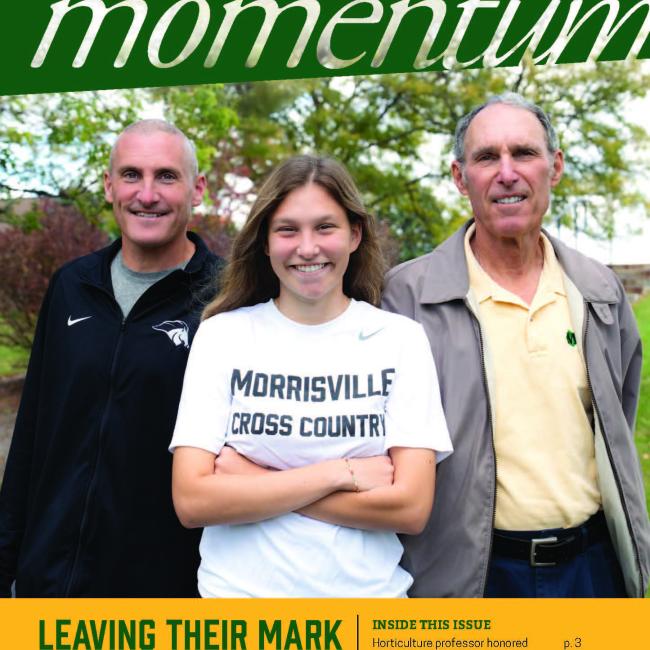Ask assistant biology professor Eric Diefenbacher what his special field of interest is and without hesitation he says “salamanders,’’ particularly spring salamanders. Why? Because “salamanders are a great bio-indicator of how healthy an environment might be overall, and that’s really important.’’
Diefenbacher says this while leading an outing with one of his students to a seep, or intermittent stream, at the Cush Hill property of Rogers Environmental Education Center, in Sherburne, not far from the Morrisville State College Norwich Campus. The pair hike into a densely wooded area, take note of trees downed as a result of summer’s pounding rain and thunderstorms, record the air and water temperature and crouch to gently lift rocks, logs and brush in search of the small, brownish salamanders, or evidence of them.
If you’re in Diefenbacher’s Biology 101 class, you’ve learned by now that the area is on the edge of a major “salamander hotbed,’’ and that no one has done a survey of the salamanders in decades. The slimy creatures have no lungs, breathe entirely through their skin and can often be found in streams or streamside, in places where it tends to be damp. You also learn, as you conduct your survey, to do so with care and leave the environment as you found it.
Even if they don’t catch a glimpse of spring salamanders or their larvae, Diefenbacher’s enthusiasm for biology and undergraduate research—and getting students out into nature’s classroom—is contagious.
“This truly is almost extra-curricular for me,’’ said Kyle Brooks, 20, a human services major from Norwich. “The guy is a great teacher. He’s one of those teachers you can really tell how passionate he is about his subject.’’
For Diefenbacher, 33, working with students like Brooks is the essence of teaching. It’s one thing to stand in front of a classroom and cite facts and figures. It’s another thing entirely to engage students and keep them engaged. The salamander survey and related field work helps with that.
“Science is dynamic,’’ Diefenbacher said. “It’s not static. The students really enjoy getting out and gaining on-the-ground research experience.’’
In April, Diefenbacher and Brooks attended the SUNY Undergraduate Research Conference (SURC) at SUNY Fredonia in Western New York, a day-long event devoted to student research. Brooks presented on the Biology 101 salamander survey and its implications, and came away with a college and life experience that, down the road, could catch the eye of a hiring manager.
“Our research has real-world applications,’’ Diefenbacher said. “It’s something the students can put on their resumes.’’
Long before Diefenbacher became a researcher, professor and mentor, he had an interest in herpetology–the study of amphibians. He grew up in the rural countryside near Norwich and remembers a childhood spent largely outdoors, observing plant and animal life.
“The forest was my backyard,’’ he recalled. “My parents just opened the back door and away I went.’’
He studied biology in college, earning a bachelor’s degree from Hartwick College and a master’s degree from Marshall University in West Virginia. After graduation, he began his teaching career, initially as a science instructor at Holy Family School in Norwich, where he taught early-childhood-through-eighth-grade students the general concepts of science.
He made the transition to academia at Alderson Broaddus University in West Virginia, where he taught freshmen- and upper-level biology classes, advised students and served as an undergraduate research advisor.
As Diefenbacher and his wife added to their family, he started exploring and researching job opportunities back home. He was “pleasantly surprised’’ to see an opening for an assistant biology professor at the MSC Norwich Campus, “a well-known institution in this area that is very supportive of undergraduate research to help reinforce concepts learned in the classroom.’’
This fall marks Diefenbacher’s fourth year at the Norwich Campus. He’s teaching four classes this semester, including Introduction to Biology, Topics in Contemporary Biology and Human Anatomy and Physiology 1, but his impact goes beyond teaching.
He was instrumental in getting a new biology lab, with new equipment and tools for students, and also took a lead role in the development and creation of the Natural History Exhibit in the lobby/atrium area of Roger Follett Hall.
The exhibit gives the campus community an opportunity to observe natural history displays and live organisms that highlight particular themes, which change from year to year (or semester to semester) and have highlighted a broad spectrum of topics. For the 2016-2017 academic year, the theme was trout and aquaponics. The theme for 2017-18 is amphibians.
It’s another way Diefenbacher inspires others to appreciate biology and raise ecological awareness. “The Natural History Exhibit is a unique feature of the Norwich Campus,’’ he said. “It is a cool way faculty and staff can interact.’’

